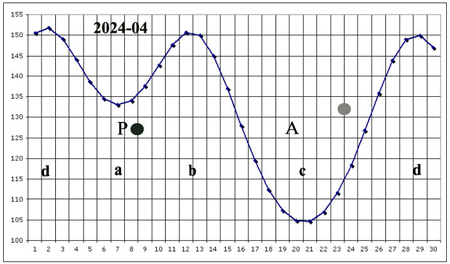
1.2.5 Discovery of the two phases - Experiment E.
When the seeds are still in relation to the surrounding matter, and in motion with regard to the Moon.
=========================================================
© copyright notice ||| français ||| italiano
=========================================================
The contribution of the experiment E.
The seed makes use of the cumulative-dissipative cycle to recover the degree of ability to germinate.
Experiment E confirmed to me what emerged during experiment C, that the seed, in order to gain degree of germinability, needs to dissipate heat when it is decreasing its angular motion, with regard to the Moon.
The experiment E confirmed my hypothesis that before the phase in which the seeds dissipate heat, there must be also a phase during which they accumulate it. But that's not all.
Moreover, experiment E made me realize that what determines the degree of recovery and increase in the germination capacity of seeds is the degree of temperature, at which they are kept when their angular velocity relative with the Moon.
It is enough to increase the temperature (well below the limits that they can endure) during this phase, called cumulative phase, before sowing, to increase yields.
For the seed stationary on the ground, its movement is relative to the Moon. The cumulative phase takes place in the periods b-c and d-a of the graph below, while the dissipative phase takes place during the periods a-b and c-d.
So, thanks to experiment E, I discovered the importance of the cumulative phase, when the seed at the same time absorbs heat and its angular velocity relative to other matter increases.
Procedure of the experiment E.
It involves keeping two sets of seeds, at different temperatures, during the cumulative periods b-c, or d-a (cumulative phases). The seeds are sown during the next dissipative phase, so c-d, or a-b respectively, or better still just before its beginning.
The greater the difference between the two temperatures of the two sets (well below the limits that the seeds can withstand), the greater the difference in the productivity between the two sets of seeds. In favor of seeds kept at the highest temperature during the cumulative phase before sowing.
--- O ---
To be precise, experiment E made me understand or confirm:
(1) that the cycle is activated by the angular movement of the seeds with respect to other matter and by heat exchanges consistent with the movement, which means:
(1a) the seed is in the cumulative phase when it is increasing its angular motion relative to other matter and at the same time heat exchanges go towards the seed;
(1b) the seed is in the dissipative phase when the angular motion decreases relative to other matter and contextual heat exchanges are towards the outside (it is dissipated);
And also:
(2) that the cumulative phase precedes the dissipative phase; which means:
(2a) that the efficiency of the cycle to keep the seed viable over time usually depends on the temperature at which it is kept during the cumulative phase that precedes sowing (naturally within the limits that the seed can withstand);
(2b) that during the dissipative phase, the seed operates as a consequence of what happened in the cumulative phase, except in cases where the conditions do not allow adequate dissipation.